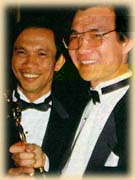| Human history has been spotted by bloody holocausts. Dith Pran survived one of the bloodies holocaust in human history, the Cambodian Holocaust by the Communist Khmer Rouge in late half of 1970s. Under the Maoist leadership led by Pot Pot, 1.7 million people out of 7.9 million population were perished. Holocause left victims and survivors. A brave survivor sprang up in his voice to awake the rest of the world to recognize the tragedy. Pran's story was portrayed by the Academy award winning movie, the Killing Field. Now he has his own voice as, 
"Part of my life is saving life. I don't consider myself a politician or a hero. I'm a messenger. If Cambodia is to survive, she needs many voices."Pran was born on September 27, 1942, in Angkor Wath, famous historic site with the Buddhist temple. He worked for the tourist business until the civil war spread across the border with Vietnam. He changed his career as a war correspondent to make a team with Sydney Schanberg, then a New York Time correspondent. They covered the Cambodian civil war from 1972 to 1975.The overturn by the communist Khmer Rouge on April 12, 1975 changed Pran's destiny forever. The U.S. supported Ron Noll's government fell into the hand of Maoist leader Pot Pot. On the day, Pran and Schanberg still covered the fall of the capital, Phnom Penh. It did not take long for them to be arrested by Khmer Rouge, the anti-American guerillas. The young guerillas put guns to their heads for instant execution."They are French journalists!" Dith shouted. "They are here to write about your great victory." He talked non-stop attempting to persuade the guerillas to release them. When they were set free, they rushed into the French embassy. Later Schanberg was expelled from Cambodia and Pran headed toward his hometown disguising himself as a taxi-driver. Pran heard that his wife and children successfully escaped out of the country with foreigners.The philosophy of the Khmer Rouge, symbolized by the word of 'Angka,' was to return the Cambodian society to a primitive community. All towns and cities were emptied and all hospitals and schools were closed. They propagated their philosophy as "Angka is taking us back to year zero."Dith Pran was located at one of labor camps where he worked as a cook for blacksmiths. Desperate for food, he crept into the rice field and grabbed a handful of grain. However, he was captured by guards, half of whom were teenage girls. They beat him with butt-ends bamboo sticks. Fortunately he was released after a night on his knees with his arms and legs bound together.North Vietnamese invaded Cambodia in December 1978. The Vietnamese troops captured Phnom Penh the following year. Dith came back to his hometown only to discover that his father had starved to death in 1975, the Khmer Rouge executed his three brothers and his sister was murdered with her husband and two children. Pran crossed the jungle seeded with land mines to refugee camp in Thailand border leaving his country behind. Sydney Schanberg, the New York Times journalist, took the first flight to Thailand just after hearing Pran's survival. On first seeing Sydney at the refugee camp, Dith told with almost a fainted voice, "You must write it." In 1976, Schanberg was awarded by Pulitzer Prize for his coverage of Cambodia civil war. He accepted the Prize with the name of Dith Pran. Finally Pran flew over to the U.S. and reunited with his family. Since 1980 he has worked as a photojournalist for the New York Times.
 Sydney wrote a moving story titled "The Death and Life of Dith Pran" for the New York Times Magazine in January 1980. This story was recreated into the movie, "The Killing Fields."Pran devoted his life to advocating the tragedy in Cambodia and to bringing Pol Pot to international justice. He kept saying "As a survivor, I must speak out." His effort contributed to passing the Cambodian Genocide Justice Act by the U.S. Senate. At the same time, the State Department provided a $500,000 grant to Yale University for the Cambodian Genocide Project. He founded "The Dith Pran Holocaust Awareness Project, Inc" to educate the world and the U.S. students about the Cambodian Genocide which occurred from April 17th, 1975 to January 7th, 1979. Sydney wrote a moving story titled "The Death and Life of Dith Pran" for the New York Times Magazine in January 1980. This story was recreated into the movie, "The Killing Fields."Pran devoted his life to advocating the tragedy in Cambodia and to bringing Pol Pot to international justice. He kept saying "As a survivor, I must speak out." His effort contributed to passing the Cambodian Genocide Justice Act by the U.S. Senate. At the same time, the State Department provided a $500,000 grant to Yale University for the Cambodian Genocide Project. He founded "The Dith Pran Holocaust Awareness Project, Inc" to educate the world and the U.S. students about the Cambodian Genocide which occurred from April 17th, 1975 to January 7th, 1979. |
Biography- Worked as a war correspondent for the New York Times in Cambodia from 1972 to 1975
- Survived the Cambodian Holocaust by the Khmer Rouge
- Flew over to the U.S. in 1979
- Photojournalist for the New York Times since 1980
- Movie 'The Killing Fields' portrayed his story won Academy Award in 1984
- Appointed Goodwill Ambassador by the United Nations High Commissioner for Refugees in 1985
- Compiled 'Children of Cambodia's Killing Fields: Memoirs by Survivors' published by Yale University in 1997
- Ellis Island Medal of Honor recipient in 1998
- Founder and President of The Dith Pran Holocaust Awareness Project, Inc
|


 Sydney wrote a moving story titled "The Death and Life of Dith Pran" for the New York Times Magazine in January 1980. This story was recreated into the movie, "The Killing Fields."
Sydney wrote a moving story titled "The Death and Life of Dith Pran" for the New York Times Magazine in January 1980. This story was recreated into the movie, "The Killing Fields."